EGFG ransomware locks entire computer files through encryption
Contents
EGFG ransomware is a dangerous emergent variant of computer virus. It was recently released by the notorious STOP/DJVU cybercriminal family. Once it is able to penetrate a computer system, it will trigger a series of illegal processes in order to gain control and encrypt all files that are available on the system. While the attack is still ongoing, the virus will mark every file it comes across with .egfg extension. Below are examples to better explain how this process occurs, file 1.jpg will be renamed 1.jpg.egfg, file 2.txt will be renamed 2.txt.egfg, etc.
In order to notify the computer user about what just occurred, _readme.txt file will be dropped in all the folders. This file is more or less a ransom note and will emphasize that a ransomware attack has taken place and those behind it have successfully encrypted all data contained in the computer by using complex algorithms. Therefore, the victim is expected to pay certain fees as ransom so they could receive EGFG decryption tool/key.

Ransom note contents explained
The first line of the _readme.txt ransom note will be written in such a way to draw the victim’s attention. Going further in the message, they will state that every data contained in the computer, such as documents, videos, photos etc., have all been encrypted successfully with the use of a strong and unique encryption key. However, they will equally point out that the victim can still recover their files by making use of the decryption key and software they have in their possession. Therefore, they would have to pay to obtain it or totally lose their important files.
The aim of the attack in the first place is to extort the victim by encrypting or taking their files hostage pending when ransom would be paid. They would also suggest that victims should reach out to them via two email addresses kept in the _readme.txt ransom note i.e. manager@time2mail.ch and supportsys@airmail.cc.
As suggested in the ransom note, the victim is at liberty to randomly forward any of the encrypted files to one of the email addresses for possible test decryption. They will also mention a specific amount the victim is expected to pay in exchange for the promised decryption tool/software and keys.
The note will further explain that even though the ransom fee is $980, they are willing to offer a 50% discount provided the victim can respond within 72 hours/3 days following the ransomware attack. In other words, they would accept $490 to decrypt the files based on the conditions stated above. It doesn’t end there; they would also direct the victim to use any available cryptocurrency exchange platforms in purchasing cryptos like Bitcoin that is worth the ransom amount and would have to transfer same to a virtual wallet address provided by the cybercriminals.
The deductible reason why they prefer this payment option is that it makes them untraceable. The cybercriminals are aware that law enforcement agents may follow the money trail to apprehend them if they use any other conventional payment method to receive ransom.
Below is a screenshot of the _readme.txt ransom note the cybercriminals usually forward to their victim’s computer.

Whatever is the case, the general advice as put forward by cybersecurity experts, including FBI is NO TO RANSOM PAYMENT. The primary reason is that paying the ransom does not guarantee file recovery, and worse still, it enables cybercriminals to enhance their capacity and attack more people. It should also be noted that victims who pay a ransom are often targeted repeatedly in the future.
Other risk factors aligned with ransomware attacks
EGFG ransomware virus, just like other variants of STOP/DJVU is infamous for releasing additional malware on the already infected computer. Such malware, including AZORULT and VIDAR Trojans can stealthily obtain vital information such as banking details, passwords, cryptocurrency wallets and browsing history etc. Beware that such sensitive information in the hands of cybercriminals could lead to further crimes like blackmail and theft.
Other risks include the deleting of Volume Shadow Copies, modification of some system processes and files, as well as opening loopholes that could be leveraged by the cybercriminals to further compromise the computer by adding more malware.
This is why it is very important to remove EGFG ransomware virus once it is detected in any system. The recommended safe way of doing this is to boot the infected system by way of Safe Mode with Networking option before running any genuine antivirus software. It would help if you also considered downloading RESTORO which you can use to scan your computer to check for damaged Windows OS files that can be repaired and also to fix them accordingly.
Ransomware Summary
| Name | EGFG Ransomware Virus |
| Type | Ransomware; Crypto-malware; Virtual Extortion Virus |
| Family | STOP/DJVU |
| Encryption type | RSA 2048 + Salsa20 |
| Previous versions | JYPO, KIFR, KIOP, KITZ, BOZA, BOTY, COZA (find full list here) |
| Version | 474th |
| Extension | .egfg |
| Cybercriminal emails | manager@time2mail.ch and supportsys@airmail.cc |
| Additional malware dropped | Azorult or Vidar Trojan |
| Damage | The ransomware uses encryption to maliciously modify all files on the PC and marks their original names with .egfg extension. Ransom notes called as _readme.txt will be dropped in every computer folder. This piece of malware usually drags VIDAR Stealer alongside it and also eliminates VSS from the system. On top of that, it tends to modify Windows HOSTS file to restrict computer user’s access to cybersecurity-related websites online. |
| Ransom note | _readme.txt |
| Ransom demand | $490-$980 in Bitcoin |
| Distribution | Victims often download this ransomware along illegal torrent downloads, cracked software, activators, key generators or tools like KMSPico. |
| Known software cracks to contain this malware | Corel Draw, Tenorshare 4ukey, Adobe Photoshop, Cubase, Adobe Illustrator, Internet Download Manager, Tally, League of Legends. |
| Detection names | Ransom:Win32/StopCrypt.PAL!MTB (Microsoft), Trojan.Crypt (A) (Emsisoft), HEUR:Trojan-Ransom.Win32.Stop.gen (Kaspersky), Trojan.GenericKD.47850419 (BitDefender), Trojan.MalPack.GS (Malwarebytes), ML.Attribute.HighConfidence (Symantec) see all detection name variations on VirusTotal |
| Removal | Remove ransomware and related malware from your PC using trustworthy software. To repair virus damage on Windows OS files, consider scanning with RESTORO (secure download link). |
REPAIR VIRUS DAMAGE
Scan your system for FREE to detect security, hardware and stability issues. You can use the scan results and try to remove threats manually, or you can choose to get the full version of software to fix detected issues and repair virus damage to Windows OS system files automatically. Includes Avira spyware/malware detection & removal engine.
Screenshot of files encrypted by the described ransomware version:

Ransomware infection threats and how to protect your computer
Cybercriminals often make use of phishing and other unorthodox social engineering methods to confuse and lure their victims into opening email attachments, fake/simulated ads, or pirated software contents embedded with malware. They usually make use of Word, JS formats, PDF, or Excel while giving such file names like “pending payments”, invoices or order details etc. However, once the unsuspecting victim falls for these desperate attempts, they end up becoming a victim of STOP/DJVU ransomware attack. Therefore, we strongly advise that computer users should obtain their software needs only from official pages of the producers or their affiliate partners to avoid becoming a victim.
Also, be aware that these cybercriminals usually spoof their email sender’s address as well or even make use of popular brand logos, just to catch their victims’ off-guard. Regardless, computer users can still proactively prevent such attacks by being wary at all times. Unsolicited emails and ads should be ignored.
You should also avoid going to websites that claim to offer 100% decryption solutions for any STOP/DJVU ransomware virus. Such dubious websites often have ulterior motives, including the spread of other malware variants. So far, only tools created by DiskTuna and Emsisoft have been certified okay for such.
Before we conclude, the importance of protecting your computer with a genuine antivirus can’t be overemphasized. The genuine ones can provide all-round protection even if a malicious content mistakenly lands on your computer.
Remove EGFG Ransomware Virus/Decrypt Your Files
Once again, before you remove EGFG ransomware virus, remember that your computer has to be set up in Safe Mode with Networking to ensure optimal result. This particular booting process is known to use limited features/processes thereby ensuring there is no room for the malware to hibernate. Once you have selected this booting option, the next thing would be to commence a full system scan while identifying and removing malicious files that came with the ransomware.
Likewise, our team of experts equally recommends that RESTORO should be downloaded to expedite the process of restoring Windows OS files that were affected by the STOP/DJVU virus.
At this point, it is assumed that you’ve completed EGFG ransomware removal; therefore, it is time to do the following:
- Inform any relevant law enforcement agency that is responsible for handling such challenges.
- Look for any available data backup device to use in restoring lost files.
- Study more about different variants of STOP/DJVU and how files affected by them could be salvaged.
- Change all passwords that have been typed into the system as soon as possible.
OUR GEEKS RECOMMEND
Our team recommends a two-step rescue plan to remove ransomware and other remaining malware from your computer, plus repair caused virus damage to the system:
GeeksAdvice.com editors select recommended products based on their effectiveness. We may earn a commission from affiliate links, at no additional cost to you. Learn more.
EGFG Ransomware Virus Removal Guidelines
Method 1. Enter Safe Mode with Networking
Step 1. Start Windows in Safe Mode with Networking
Before you try to remove EGFG Ransomware Virus virus, you must start your computer in Safe Mode with Networking. Below, we provide the easiest ways to boot PC in the said mode, but you can find additional ones in this in-depth tutorial on our website – How to Start Windows in Safe Mode. Also, if you prefer a video version of the tutorial, check our guide How to Start Windows in Safe Mode on Youtube.
Instructions for Windows XP/Vista/7 users
- First of all, turn off your PC. Then press the Power button to start it again and instantly start pressing F8 button on your keyboard repeatedly in 1-second intervals. This launches the Advanced Boot Options menu.
- Use arrow keys on the keyboard to navigate down to Safe Mode with Networking option and press Enter.

Instructions for Windows 8/8.1/10/11 users
- Open Windows Start menu, then press down the Power button. On your keyboard, press down and hold the Shift key, and then select Restart option.

- This will take you to Windows Troubleshoot screen. Choose Troubleshoot > Advanced Options > Startup Settings > Restart. Tip: If you can't find Startup Settings, click See more recovery options.

- In Startup Settings, press the right key between F1-F9 to enter Safe Mode with Networking. In this case, it is the F5 key.

Step 2. Remove files associated with the virus
Now, you can search for and remove EGFG Ransomware Virus files. It is very hard to identify files and registry keys that belong to the ransomware virus, Besides, malware creators tend to rename and change them repeatedly. Therefore, the easiest way to uninstall such type of a computer virus is to use a reliable security program such as INTEGO Antivirus. For virus damage repair, consider using RESTORO.
Special Offer
Compatibility: Microsoft Windows
See Full Review
RESTORO is a unique PC Repair Tool which comes with an in-built Avira scan engine to detect and remove spyware/malware threats and uses a patented technology to repair virus damage. The software can repair damaged, missing or malfunctioning Windows OS files, corrupted DLLs, and more. The free version offers a scan that detects issues. To fix them, license key for the full software version must be purchased.
Method 2. Use System Restore
In order to use System Restore, you must have a system restore point, created either manually or automatically.
Step 1. Boot Windows in Safe Mode with Command Prompt
Instructions for Windows XP/Vista/7 users
- Shut down your PC. Start it again by pressing the Power button and instantly start pressing F8 button on your keyboard repeatedly in 1-second intervals. You will see Advanced Boot Options menu.
- Using arrow keys on the keyboard, navigate down to Safe Mode with Command Prompt option and press Enter.

Instructions for Windows 8/8.1/10/11 users
- Launch Windows Start menu, then click the Power button. On your keyboard, press down and hold the Shift key, and then choose Restart option with the mouse cursor.

- This will take you to Windows Troubleshoot screen. Choose Troubleshoot > Advanced Options > Startup Settings > Restart. Tip: If you can't find Startup Settings, click See more recovery options.

- In Startup Settings, press the right key between F1-F9 to enter Safe Mode with Command Prompt. In this case, press F6 key.

Step 2. Start System Restore process
- Wait until system loads and command prompt shows up.
- Type cd restore and press Enter, then type rstrui.exe and press Enter. Or you can just type %systemroot%system32restorerstrui.exe in command prompt and hit Enter.

- This launches System Restore window. Click Next and then choose a System Restore point created in the past. Choose one that was created before ransomware infection.

- Click Yes to begin the system restoration process.
After restoring the system, we recommend scanning the system with antivirus or anti-malware software. In most cases, there won't be any malware remains, but it never hurts to double-check. In addition, we highly recommend checking ransomware prevention guidelines provided by our experts in order to protect your PC against similar viruses in the future.
Alternative software recommendations
Malwarebytes Anti-Malware
Removing spyware and malware is one step towards cybersecurity. To protect yourself against ever-evolving threats, we strongly recommend purchasing a Premium version of Malwarebytes Anti-Malware, which provides security based on artificial intelligence and machine learning. Includes ransomware protection. See pricing options and protect yourself now.

System Mechanic Ultimate Defense
If you're looking for an all-in-one system maintenance suite that has 7 core components providing powerful real-time protection, on-demand malware removal, system optimization, data recovery, password manager, online privacy protection and secure driver wiping technology. Therefore, due to its wide-range of capabilities, System Mechanic Ultimate Defense deserves Geek's Advice approval. Get it now for 50% off. You may also be interested in its full review.

Disclaimer. This site includes affiliate links. We may earn a small commission by recommending certain products, at no additional cost for you. We only choose quality software and services to recommend.
Decrypt EGFG files
Fix and open large EGFG files easily:
It is reported that STOP/DJVU ransomware versions encrypt only the beginning 150 KB of each file to ensure that the virus manages to affect all files on the system. In some cases, the malicious program might skip some files at all. That said, we recommend testing this method on several big (>1GB) files first.
- Create a copy of encrypted file to a separate folder using Copy > Paste commands.
- Now, right-click the created copy and choose Rename. Select the EGFG extension and delete it. Press Enter to save changes.
- In the prompt asking whether you want to make the changes as file might become unusable, click OK.
- Try opening the file.
STOP/DJVU decryption tool usage guide
STOP/DJVU ransomware versions are grouped into old and new variants. EGFG Ransomware Virus is considered the new STOP/DJVU variant, just like JYPO, KIFR, KIOP, KITZ, BOZA, BOTY, COZA (find full list here). This means full data decryption is now possible only if you have been affected by offline encryption key. To decrypt your files, you will have to download Emsisoft Decryptor for STOP DJVU, a tool created and maintained by a genius security researcher Michael Gillespie.
Note! Please do not spam the security researcher with questions whether he can recover your files encrypted with online key - it is not possible.
In order to test the tool and see if it can decrypt EGFG files, follow the given tutorial.
- Download the decryption tool from Emsisoft.
- Click the little arrow next to your download and choose Show in Folder.
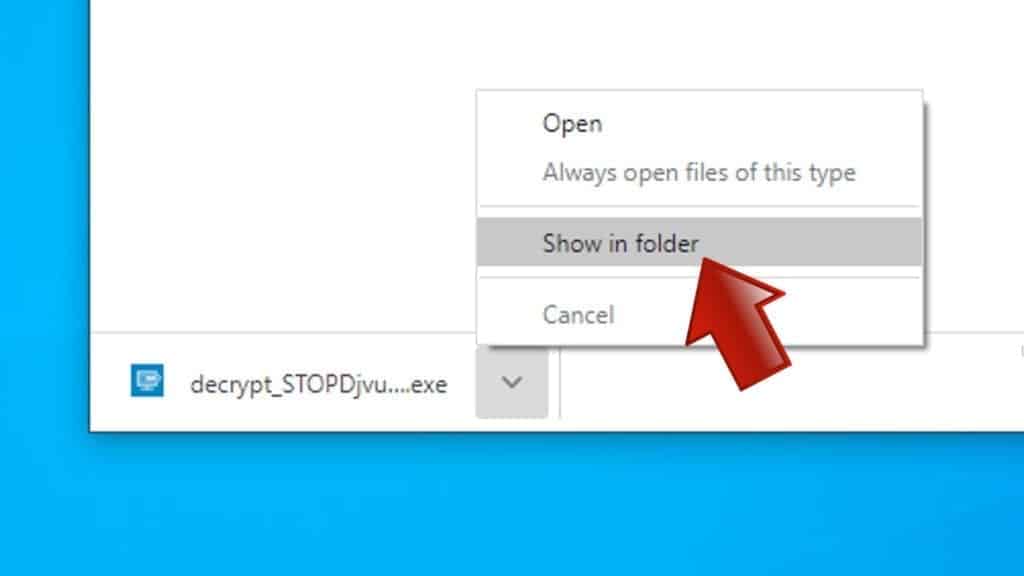
- Now, right-click the file and choose Run as Administrator. If asked, enter administrator's password.
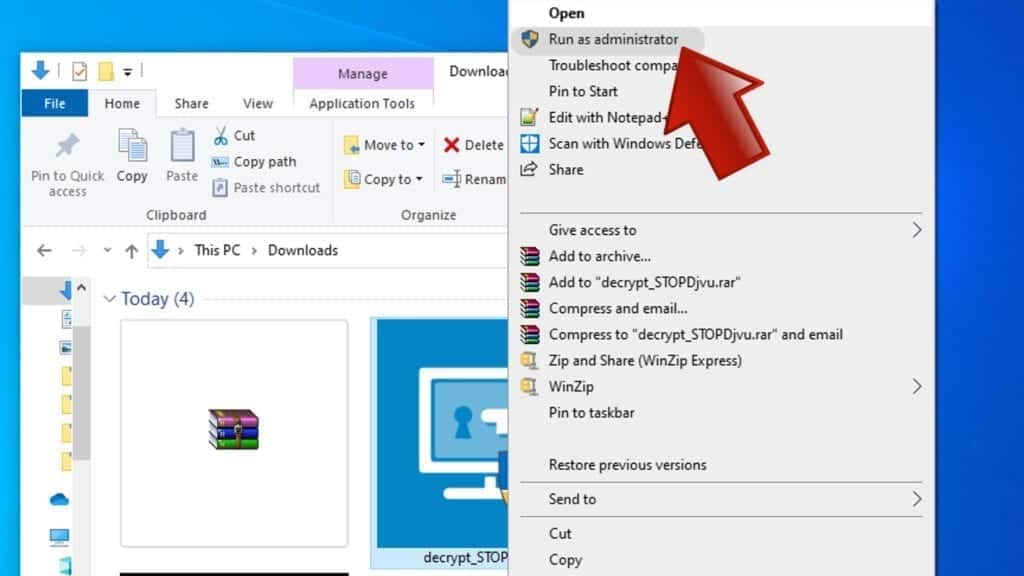
- In UAC window, click Yes.
- Click Yes to agree to software terms in both windows.
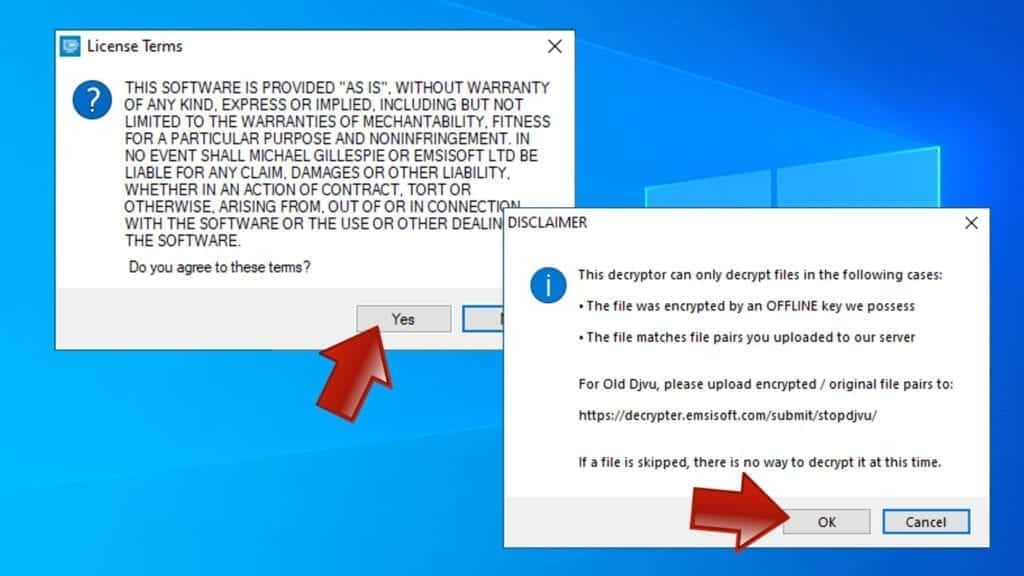
- The tool will automatically include C:// disk as a location to decrypt. The file recovery tool will prepopulate the locations to scan, including connected data storage drives or network drives. Click Add folder if you wish to add additional locations.
In Options tab, you can choose to keep encrypted file copies. We recommend leaving this option selected, especially if you do not know if the decryption tool will work.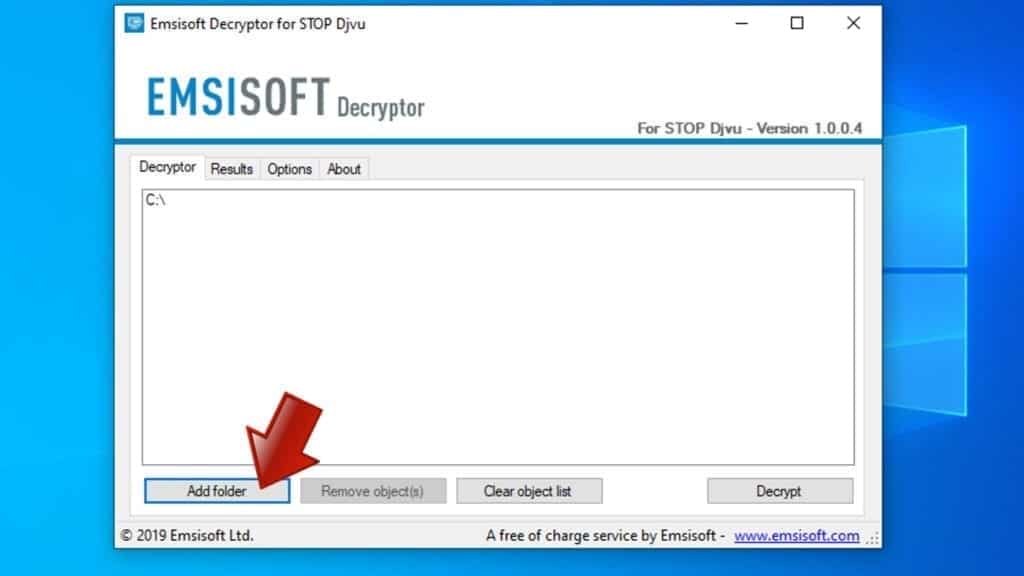
- Click Decrypt to start restoring EGFG files. You will see the progress in the Results tab. Here, you can see messages from the tool, such as whether the decryption procedure is successful, or you need to wait for an update.
You might also be informed that online key was used to encrypt your files. In such case, the decryption tool won't work for you, and the only way to recover your files is to use a data backup.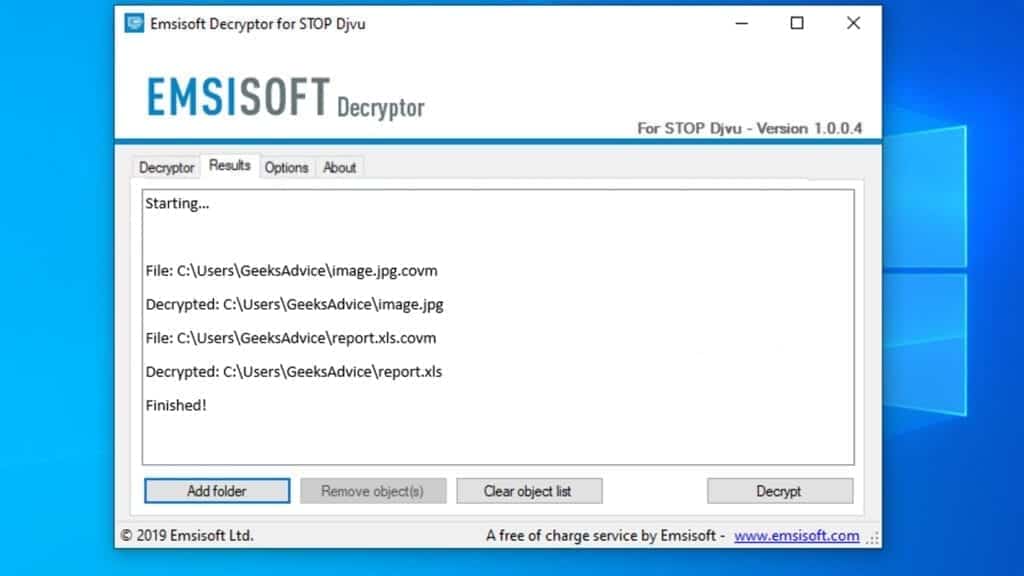
Meanings of decryptor's messages
The EGFG decryption tool might display several different messages after failed attempt to restore your files. You might receive one of the following messages:
Error: Unable to decrypt file with ID: [example ID]
This message typically means that there is no corresponding decryption key in the decryptor's database.
No key for New Variant online ID: [example ID]
Notice: this ID appears to be an online ID, decryption is impossible
This message informs that your files were encrypted with online key, meaning no one else has the same encryption/decryption key pair, therefore data recovery without paying the criminals is impossible.
Result: No key for new variant offline ID: [example ID]
This ID appears to be an offline ID. Decryption may be possible in the future.
If you were informed that an offline key was used, but files could not be restored, it means that the offline decryption key isn't available yet. However, receiving this message is extremely good news, meaning that it might be possible to restore your EGFG extension files in the future. It can take a few months until the decryption key gets found and uploaded to the decryptor. We recommend you to follow updates regarding the decryptable DJVU versions here. We strongly recommend backing up your encrypted data and waiting.
Report Internet crime to legal departments
Victims of EGFG Ransomware Virus should report the Internet crime incident to the official government fraud and scam website according to their country:
- In the United States, go to the On Guard Online website.
- In Australia, go to the SCAMwatch website.
- In Germany, go to the Bundesamt für Sicherheit in der Informationstechnik website.
- In Ireland, go to the An Garda Síochána website.
- In New Zealand, go to the Consumer Affairs Scams website.
- In the United Kingdom, go to the Action Fraud website.
- In Canada, go to the Canadian Anti-Fraud Centre.
- In India, go to Indian National Cybercrime Reporting Portal.
- In France, go to the Agence nationale de la sécurité des systèmes d’information.
If you can't find an authority corresponding to your location on this list, we recommend using any search engine to look up "[your country name] report cyber crime". This should lead you to the right authority website. We also recommend staying away from third-party crime report services that are often paid. It costs nothing to report Internet crime to official authorities.
Another recommendation is to contact your country's or region’s federal police or communications authority.
Frequently Asked Questions
You can only open EGFG files if you have the decryption key, or if you were affected by offline encryption type.
To figure out whether you were affected by offline encryption, please go to C:/SystemID/PersonalID.txt and see if the string inside of it ends in t1. You can also try using Emsisoft Decryptor for STOP/DJVU.
Please follow the guidances provided by the official EGFG decryption tools and believe what they say. If they say it is impossible to decrypt, it really is so. There is no magic tool or human capable of decrypting your files hiding somewhere. Encryption is a technique created to be nearly impossible to decrypt without a special private key (held by the criminals).
We advise scanning with anti-virus, anti-malware, malware removal tools or software like RESTORO to eliminate virus damage on the system. If you do not trust using a single tool, try running one after another. However, we do not recommend keeping several security programs on a computer at once as they can interfere with each other's work.
Beware of fake EGFG decryption tools circulating around the web. Cyber criminals are uploading them to various shady websites, also might be promoting them via suspicious Youtube videos. These programs can infect your computer even more heavily (Trojans, miners, etc.). We suggest being extremely cautious around the web. If there will be an official STOP/DJVU decryption tool available, it will be widely discussed in public media.

Norbert Webb is the head of Geek’s Advice team. He is the chief editor of the website who controls the quality of content published. The man also loves reading cybersecurity news, testing new software and sharing his insights on them. Norbert says that following his passion for information technology was one of the best decisions he has ever made. “I don’t feel like working while I’m doing something I love.” However, the geek has other interests, such as snowboarding and traveling.


Leave a Reply